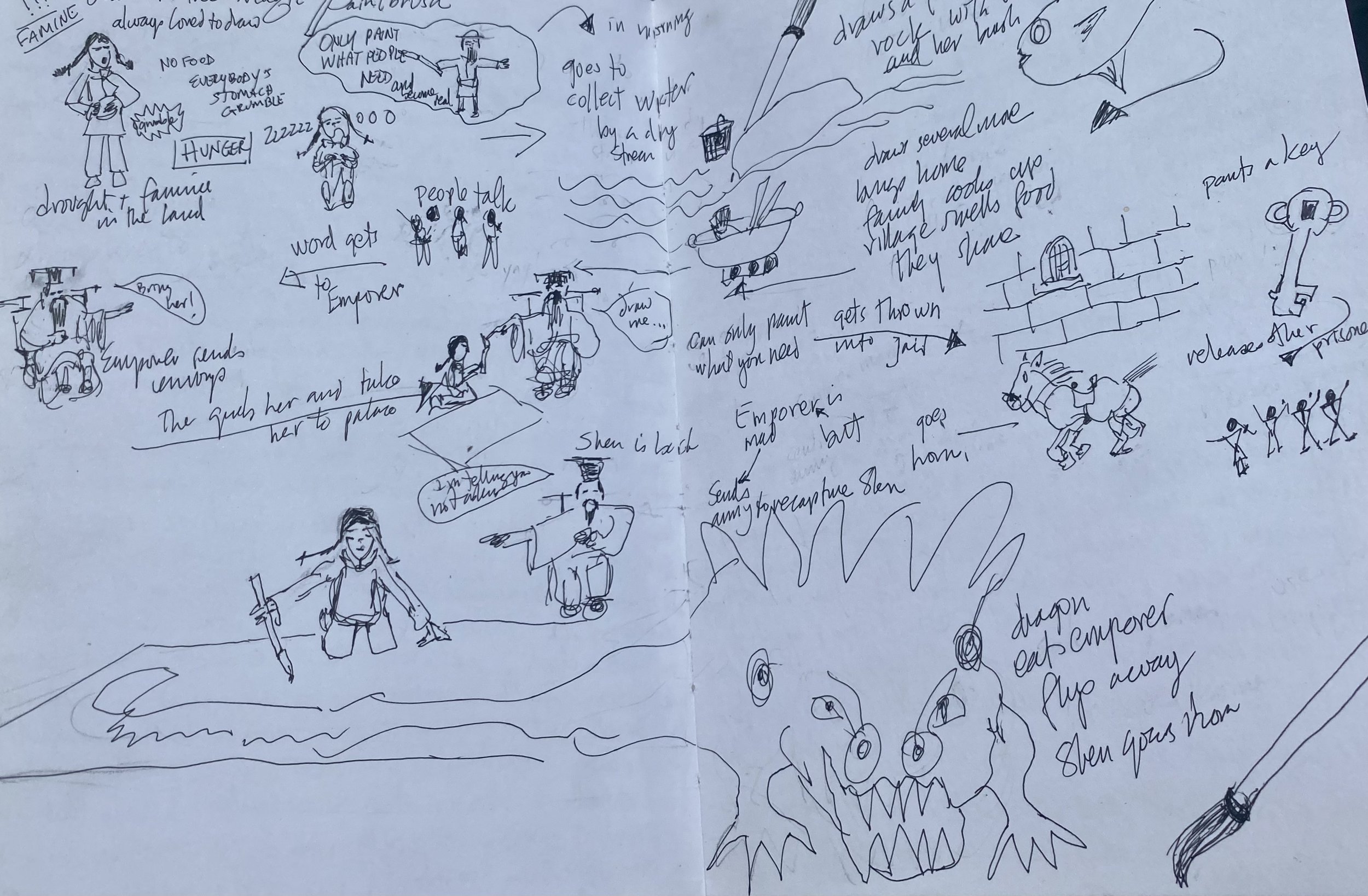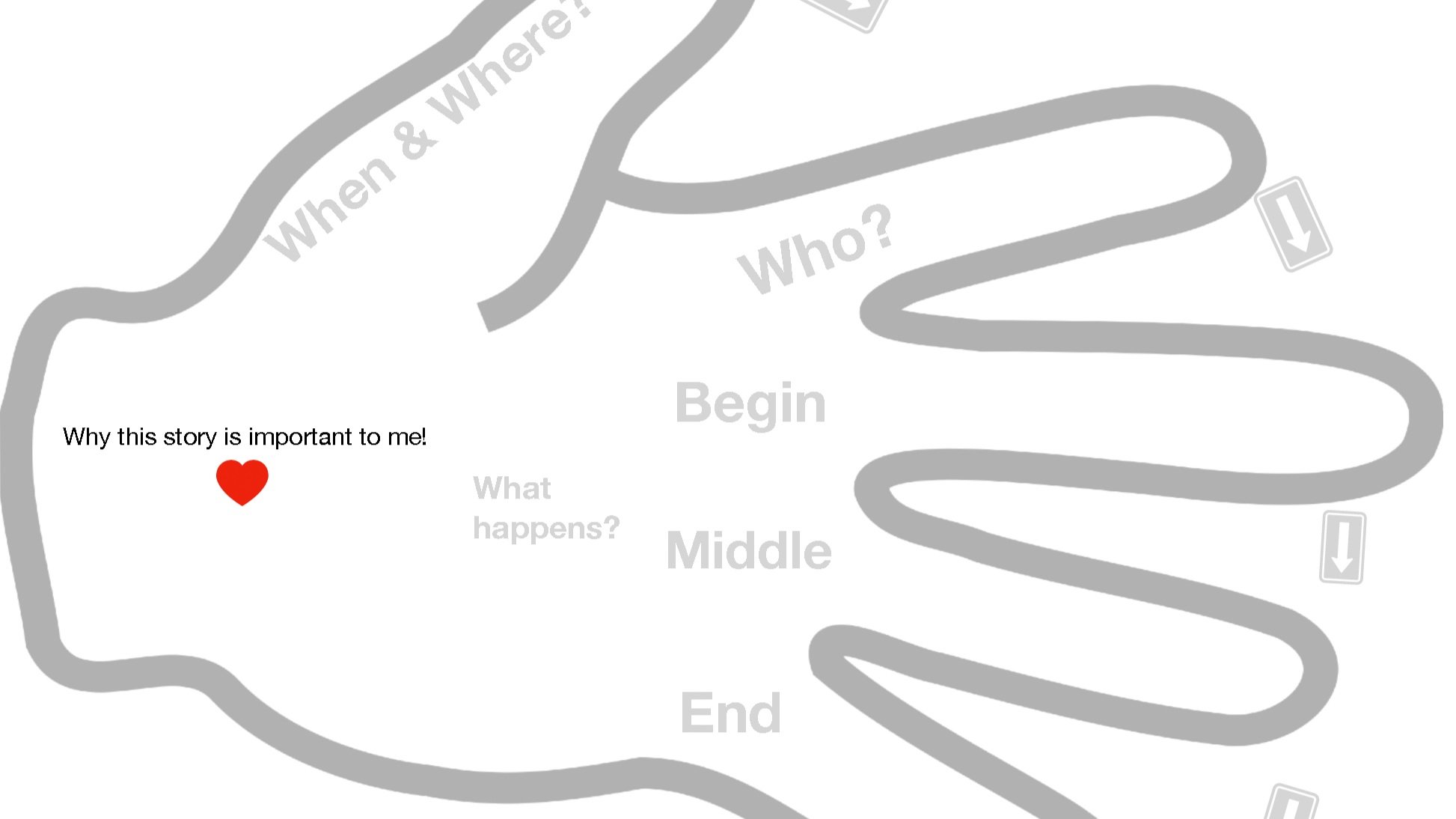Story map of Shen and Magic Paintbrush. I use these to learn my stories.
Using story maps to learn visual art to extend stories
"Sorry, Majesty. I wish to obey..."
The Magic Paintbrush by British author Julia Donaldson is a rhyming version of the traditional Chinese story in which a child is given a magic paintbrush which will bring to life everything that she paints. In this version she must only paints things for for people who need them. When the Emperor, a greedy and unkind man, hears of the magic brush he demands that Shen be brought to him and then she must paint him a tree of golden coins. She draws a tree but refuses to finish and he sends her to prison. Shen escapes by painting a key and then a horse but the Emperor and his men follow her back to her village. The Emperor demands Shen perform for him and she starts to paint a dragon, who will become real and ‘ready for a meal’ if she finishes the painting. The Emperor realizes he is bested and flees back to his palace, leaving the villagers to revel and feast.
Another version of this story, Liang and the Magic Paintbrush was written and illustrated by Demi back in the 1990s. She told the tale with a male protagonist and it was a favorite of our family as well as a Reading Rainbow book.
I like to use this story get students to think of "what if..." questions and and ask "What if you had a magic paint brush - what would you paint for yourself? Do you need it or simply want it?" And a natural extension of this is to ask them to draw somethings they want. Or wish existed.
During my work with ReadBoston.org I like to incorporate the idea of drawing about stories, When weather and time permit, I may leave some chalk drawings outside the sites where I perform. Sometimes I leave some chalk too.
The tale of a magic paintbrush is a Chinese folk tale. Below are two versions. I am telling the story as a hybrid of these two books and recommending that teachers find the book in the library and read it as well.
The Magic Paint Brush A Chinese folk tale
Once upon a time, there was a young man called Ma Liang. He was poor and kind and liked drawing so much that he drew pictures everywhere. One night, he dreamed that an old man gave him a magic paintbrush and asked him to use it to help poor people. When he woke up, he found the magic paintbrush on his desk. From that day on, he used the paintbrush whenever poor people needed help. When he saw that people had no water to use in the fields, he drew a river and the river came to life. People could bring water from the river to the field to help their crops grow. When he saw the hard working farmers struggling to feed their families, he drew more food for them to eat. Soon many people knew about the magic paintbrush and were very grateful to Ma Liang.
But in the village, there lived a rich man who was mean and decided to steal the paint brush from the young man so that he could use it to become even richer. So he sent his servants to Ma Liang's home to steal the magic paintbrush.
Once he had the paintbrush, he felt very happy and he invited his friends to come to his home so that he could show them his new possession. He drew a lot of pictures, but none of them would come to life for him. He was very angry that the paintbrush would not work for him so he sent for Ma Liang.
He said to the young man "If you draw some pictures for me and bring them to life, I will set you free." Ma Liang did not want to help such a bad man, but he had an idea. He said to the bad man, "What would you like me to draw?"
The rich man said, "I want a golden mountain. I will go there to gather gold." But the young man drew a sea first. The rich man was angry and said," Why did you draw a sea? I want a golden mountain. Draw it quickly!"
So the young man drew a golden mountain which was far away from the sea. The rich man said, "Draw a big ship quickly. I want to go there to gather gold." The young man smiled quietly and drew a big ship. The rich man jumped into the ship and set off to find the gold but when the ship sailed to the middle of the sea, Ma Liang drew a large wave which destroyed the ship and the rich man was never seen in the village again.
After that, the young man lived with his family happily and used the magic paintbrush to help the poor people as the the old man had asked him to do. Ma Liang and his the magic paintbrush were known and loved by everyone.
Ma Liang and his Magic Paintbrush
Once upon a time, in China, there lived a poor boy called Ma Liang. He had to work hard every day, gathering firewood, washing pots, scrubbing floors, etc. He loved to draw, but he was too poor to buy a paintbrush.
"I can draw on the ground with stick!" he said to himself, "But I could paint picture for poor people if I have a paintbrush."
Suddenly an old man appeared. He held out a paint brush, and gave it to Ma Liang. "Now you can paint pictures for poor people," he said.
The old man disappeared, leaving the paintbrush in Ma Liang's hand. Ma Liang started to paint immediately. He painted a butterfly, but the butterfly came to life and flew away! this was a magic paintbrush!
Soon everyone in the village heard about Ma Liang's paintbrush. Poor people began to ask him to paint things they needed.
"I am so hungry! Please paint me some rice." One poor man asked.
Ma Liang painted rice for him.
"Please paint me some fishes." asked another.
"Here you go. Be careful, it's very slippery!"
"I am cold! Please paint me a coat." asked another, he was shaking in the freezing wind.
"Here, this will keep you warm." Ma Liang painted him the warmest coat.
Soon the story of the boy with the magic paintbrush spread across China to the royal palace. Even the emperor knew about Ma Liang.
The emperor was a very greedy man. He said to Ma Liang: "Draw me a tree covered with gold coins!"
Ma Liang refused said: "No, I only paint for poor people!"
The emperor was furious! "Lock him up!" The emperor ordered his guards to threw Ma Liang into prison.
Ma Liang was hungry, cold, and lonely in the prison. Suddenly the old man who gave Ma Liang the magic paint brush appeared. He said, "Ma Liang, did you forget your paintbrush? It can save your life too!"
This reminded Ma Liang. He started to draw. He painted an Island, on the island, there were a lot of trees covered gold coins. And then he draw a huge sail boat mooring at the port waiting for sail.
The next morning, when the emperor came to the prison, and saw the Island. He immediately order to sail to the Island with all his ministers and grandees.
When the emperor was on board, and ordered Ma Liang to draw winds to send the sail. Ma Liang started to draw, but he drew hurricane instead wind, and thick black clouds and heavy rains, too. The typhoon blew the boat far away in the sea, and the emperor's ship wrecked in thunderstorm, and they never came back.
Ma Liang waked back to his village, and he told everyone what happened. The he went on painting things for poor people. All villagers lived happily ever after.
Here are some ideas for using visuals to enhance engagement with story:
At the end of each storytelling performance all the children get to pick out a book to keep for ever.






